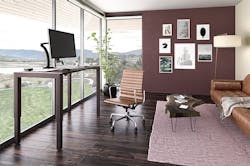It’s no surprise that COVID-19 has upended the design of the modern workplace.
Currently, workplaces are being reimagined to accommodate the “new normal,” which for many organizations is a “hybrid” approach. For more than a year, most employees have been working remote and, by the way, many have found they are not only successful doing their job from the confines of their home, but happier.
As employers usher workers back to the office, the hybrid approach is not just appealing to their workers, but almost an expectation. Allowing employees to choose working in the office some days, while working someplace else on other days is a consideration many companies are offering to not only accommodate employee flexibility, but for employee retention in general. For many employees, this is a personally balanced work style; it offers them the flexibility to work where they like with a high level of autonomy.
This is a significant paradigm shift. Employees have proven they can work well outside of the office individually. They’ve developed new behaviors, habits and the skills necessary to be productive working remotely and autonomously. Employers recognizing this new reality will be rewarded. But it won’t be easy. They must rethink how they will support these new behaviors and expectations, both for office and remote work.
However, something hasn’t changed. When it comes to the office, if the pandemic taught us anything, it’s that nothing can replace the human interaction and connections that occur when we gather together in a physical space. We can work individually anywhere, but when it comes to connectivity, physical space to iterate and collaborate is most effective in person.
Now more than ever, we need common spaces where we can gather with others, spark ideas and form stronger bonds. But employers must go a step further. They need to provide employees with the tools they need to be productive—whether that’s at the office, at home or at another remote location.
Here are three tips designers and employers can keep in mind.
1. Support the WFH Worker
Despite its challenges, the pandemic showed us that the work-from-home (WFH) model brings several benefits. Employees can perform individual work most anywhere while also participating in Zoom meetings from the comfort of their home. Workers were controlling their work environment according to the space and resources that were available. A lot of work was being done at kitchen tables while creating makeshift standing height solutions (picture a laptop stacked on top of books at a kitchen table).
But, let’s be honest, there were plenty of poor ergonomic solutions being created—ill-lit and unattractive Zoom calls were one thing, but improper screen and desk height or non-ergonomic seating were really the big deal-breakers when it came to performance.
Many WFH solutions and products are not optimal. Most workers are not using the same commercial-grade products for their home as those selected for the office—and they should be if hybrid work schedules are in their future. Whether working in the physical office or at home, employers should provide their people with the same high-quality, ergonomically correct workplace products specified for the office as for WFH. By doing this, they are demonstrating a commitment to helping their employees be healthy and successful, no matter where they choose to work.
[Related: Designing a Post-COVID Workplace That Helps Employees Feel Better]
Think of hybrid home offices as an extension of the physical office space. Employers should consider the total scope of workplace offerings. This can range from design-forward, commercial-grade height-adjustable desks and quality task chairs to ambient lighting solutions, mobile storage units and ergonomic monitor arms.
A final consideration for WFH solutions is that no two employees have the same at-home environment. Employers should consider a breadth of product solutions to meet the needs of workers, whether they are in a 600-square-foot apartment and need a stowable desking solution or in a 2,600-square-foot home and want a full home office setup. Organizations that supply a variety of individualized product considerations and offerings for the employee certainly make them feel respected and simply go a long way for the employee.
2. Offer Flexible Product Solutions
Products for the post-pandemic office should be highly flexible for workers and the newly rethought workplace.
Mobile tables and workstations can be a perfect solution to maximize a fluid environment. With tables and workstations on casters, employees not only have a “grab-and-go” solution but can turn individual work to collaborative work in a matter of moments.
The ability to roll their desk into a meeting when they need to collaborate with teammates, or easily relocate their table to a quiet or private area when focused work is required, gives the user control of where and how they want to work. In addition, multi-functional and space-optimized products that have flip-down surface top features (some with whiteboards—great for iteration sessions with others) which can “stack and stow” are terrific solutions to pop-up work.
Flexibility doesn’t have to be only about mobility. Providing individual, flexible solutions for an employee in a fixed workstation environment is also inherently important. Height-adjustable desks and monitor arms provide a worker with the choice to change their posture and how they work throughout the day. This ability to adjust their equipment for better body alignment and body movement leads to more mental stimulation and less personal injury.
3. Provide “Destination” Choices
Whether working from the office or at home, it’s important to identify different destinations to work. Each spot or location offers something different—maybe a simple change in scenery, a change in posture or a quiet spot. The act of moving from one location to another provides multiple physiological benefits, such as increased blood flow and brain stimulation.
Employers who integrate a variety of places that allow alternative ways for employees to posture and come together or to be alone will offer an attractive element to their new workplace. For a new take on collaborative environments, again, think flexible products that can come together or even soft seating in a comfortable lounge setting with mobile tables that can be added to support the worker.
Providing heads-down, quiet work areas is essential as well. These destinations offer greater privacy where interruption needs to be at a minimum. Because of their adaptability, wall-mounted height-adjustable desks (think “phone booths”) can be a smart idea. With a small footprint and typically no power required, these desks can be installed along virtually any wall. This allows the interior of the workplace to be maximized for collaboration or other purposes.
What’s Ahead
The pandemic’s effect on the modern workplace continues to shake out. And while we may not have all the answers right now, we know a few things for sure. Employees have proven they can work remotely and autonomously yet crave the opportunity to collaborate with colleagues in person—hence the rise of the hybrid work model. By supporting and empowering their people with flexible workspaces, quality tools and choices to control their environments, employers are creating a timeless recipe for success: A happier and more productive workforce.
About the author: Libby Ferin is the vice president of marketing for HAT Collective, an innovative and ergonomic-focused workplace solutions brand that allows people to work their way.
Read next: Long-Term Design Solutions to Create Meaningful, Lasting Workplaces Post-Pandemic
About the Author

firstName lastName
i+s partners with design practitioners and other industry experts to deliver informative and engaging content on a variety of topics related to commercial interior design, from the latest trends, research and technology to innovative projects, products and educational CEUs. Interested in becoming a contributor? Contact us today!
